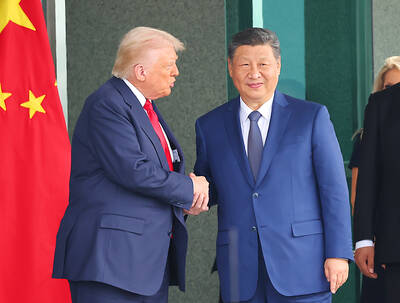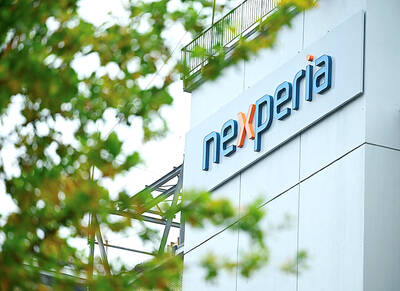Acer Inc (宏碁), the world’s fourth-largest PC vendor, yesterday reported its second quarterly net loss in a row, but said its operating loss in the third quarter had greatly improved from the second quarter.
In the three months that ended on Sept. 30, the company’s net loss was NT$1.1 billion (US$36 million), or a loss of NT$0.43 per share, Acer said in an e-mailed statement.
The figure represented a significant improvement from a net loss of NT$6.79 billion, or a loss of NT$2.57 per share, in the second quarter. On an annual basis, however, that compares with a net income of NT$4.29 billion, or earnings per share of NT$1.61, in the third quarter last year, company data showed.
Over the past two quarters, Acer has been working to adjust its inventories and fine-tune its business strategy in the face of declines in netbook and notebook sales because of the impact of tablet devices, such as the iPad.
The company is also undergoing restructuring pains following the departure of a number of key executives, such as former chief executive Gianfranco Lanci, former global marketing vice president Gianpiero Morbello and the former president of its handheld intelligence group, Aymar de Lencquesaing.
On a positive note, the company’s consolidated revenue increased 14.9 percent quarter-on-quarter to NT$117.3 billion in the third quarter, although the figure was still nearly 30 percent lower than a year earlier.
“Acer’s third-quarter consolidated revenue grew from the second quarter, with channel inventories significantly reduced to a reasonable level,” the statement said.
Operating loss in the third quarter also dropped 81.4 percent to NT$1.32 billion from NT$7.09 billion in the second quarter, after the company wrote off US$150 million of inventories in Europe and on its account receivables in Spain in the second quarter, as well as earmarking another US$30 million for layoff-related expenses.
“Comparing the two quarters’ operating losses on the same bases, by deducting the one-time sales allowance and senior executive severance fees that took place in the second quarter, the margin of the third-quarter operating loss has improved from the second quarter,” Acer said in the statement.
In the first three quarters of the year, Acer’s consolidated revenue totaled NT$347.2 billion, down 27.7 percent from a year ago. The company said operating losses amounted to NT$6.48 billion in the first three quarters, while net losses were NT$6.71 billion, or a loss of NT$2.55 per share.
The company did not provide a sales guidance or an earnings outlook for the current quarter.
Acer chairman and chief executive J.T. Wang (王振堂), who said in August that the company might not be able to break even this year, may shed some light on the progress of the company's restructuring and any impact from potential supply-chain disruption because of the floods in Thailand on Friday next week during its quarterly conference with investors and analysts.
Acer shares fell 1.24 percent to close at NT$35.80 before the announcement of the third-quarter results. The stock has plunged 60.27 percent since the beginning of the year, compared with the benchmark index’s decline of 19.15 percent during the same period.

RUN IT BACK: A succesful first project working with hyperscalers to design chips encouraged MediaTek to start a second project, aiming to hit stride in 2028 MediaTek Inc (聯發科), the world’s biggest smartphone chip supplier, yesterday said it is engaging a second hyperscaler to help design artificial intelligence (AI) accelerators used in data centers following a similar project expected to generate revenue streams soon. The first AI accelerator project is to bring in US$1 billion revenue next year and several billion US dollars more in 2027, MediaTek chief executive officer Rick Tsai (蔡力行) told a virtual investor conference yesterday. The second AI accelerator project is expected to contribute to revenue beginning in 2028, Tsai said. MediaTek yesterday raised its revenue forecast for the global AI accelerator used

TEMPORARY TRUCE: China has made concessions to ease rare earth trade controls, among others, while Washington holds fire on a 100% tariff on all Chinese goods China is effectively suspending implementation of additional export controls on rare earth metals and terminating investigations targeting US companies in the semiconductor supply chain, the White House announced. The White House on Saturday issued a fact sheet outlining some details of the trade pact agreed to earlier in the week by US President Donald Trump and Chinese President Xi Jinping (習近平) that aimed to ease tensions between the world’s two largest economies. Under the deal, China is to issue general licenses valid for exports of rare earths, gallium, germanium, antimony and graphite “for the benefit of US end users and their suppliers

Dutch chipmaker Nexperia BV’s China unit yesterday said that it had established sufficient inventories of finished goods and works-in-progress, and that its supply chain remained secure and stable after its parent halted wafer supplies. The Dutch company suspended supplies of wafers to its Chinese assembly plant a week ago, calling it “a direct consequence of the local management’s recent failure to comply with the agreed contractual payment terms,” Reuters reported on Friday last week. Its China unit called Nexperia’s suspension “unilateral” and “extremely irresponsible,” adding that the Dutch parent’s claim about contractual payment was “misleading and highly deceptive,” according to a statement

Artificial intelligence (AI) giant Nvidia Corp’s most advanced chips would be reserved for US companies and kept out of China and other countries, US President Donald Trump said. During an interview that aired on Sunday on CBS’ 60 Minutes program and in comments to reporters aboard Air Force One, Trump said only US customers should have access to the top-end Blackwell chips offered by Nvidia, the world’s most valuable company by market capitalization. “The most advanced, we will not let anybody have them other than the United States,” he told CBS, echoing remarks made earlier to reporters as he returned to Washington